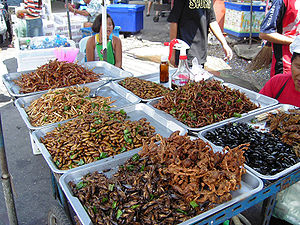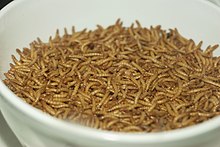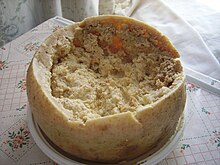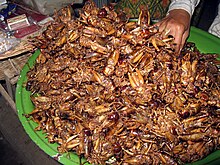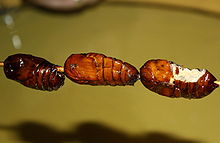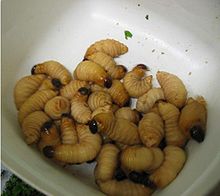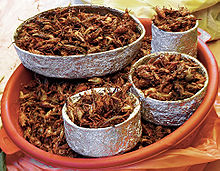Entomophagy describes the practice of eating insects by humans (as well as by non-human species).
The eggs, larvae, pupae, and adults of certain insects have been eaten by humans from prehistoric times to the present day. Around 3,000 ethnic groups practice entomophagy. Human insect-eating is common to cultures in most parts of the world, including Central and South America, Africa, Asia, Australia, and New Zealand. Eighty percent of the world's nations eat insects of 1,000 to 2,000 species. In some societies entomophagy is uncommon or taboo.
Today, insect eating is uncommon in North America and Europe, but
insects remain a popular food elsewhere, and some companies are trying
to introduce insects as food into Western diets. FAO has registered some 1,900 edible insect species
and estimates that there were, in 2005, some two billion insect
consumers worldwide. They suggest eating insects as a possible solution
to environmental degradation caused by livestock production.
Definition
Mealworms presented in a bowl for human consumption
Entomophagy is sometimes defined broadly also to cover the eating of arthropods other than insects, including arachnids and myriapods.
Insects and arachnids eaten around the world include crickets, cicadas, grasshoppers, ants, various beetle grubs (such as mealworms, the larvae of the darkling beetle), various species of caterpillar (such as bamboo worms, mopani worms, silkworms and waxworms), scorpions and tarantulas. There are over 1,900 known species of arthropods which are edible for humans.
Recent assessments of the potential of large-scale entomophagy
have led some experts to suggest insects as a potential alternative
protein source to conventional livestock, citing possible benefits
including greater efficiency, lower resource use, increased food security, and environmental and economic sustainability.
In non-humans
Entomophagy among animals: The giant anteater is a mammal specialized in eating insects
Insects, nematodes and fungi that obtain their nutrition from insects are sometimes termed entomophagous, especially in the context of biological control applications. These may also be more specifically classified into predators, parasites or parasitoids, while viruses, bacteria and fungi that grow on or inside insects may also be termed "entomopathogenic".
History
Carving of Cave grasshopper on animal bone discovered in the Magdalenian grotto of Les Trois Frères indicates a possible link with food magic.
Before humans had tools to hunt or farm, insects may have represented
an important part of their diet. Evidence has been found analyzing coprolites from caves in the US and Mexico. Coprolites in caves in the Ozark Mountains were found to contain ants, beetle larvae, lice, ticks, and mites. Evidence suggests that evolutionary precursors of Homo sapiens were also entomophagous. Insectivory also features to various degrees amongst extant primates, such as marmosets and tamarins, and some researchers suggest that the earliest primates were nocturnal, arboreal insectivores. Similarly, most extant apes are insectivorous to some degree.
Cave paintings in Altamira,
north Spain, which have been dated from about 30,000 to 9,000 BC,
depict the collection of edible insects and wild bee nests, suggesting a
possibly entomophagous society. Cocoons of wild silkworm (Triuncina religiosae) were found in ruins in Shanxi
Province of China, from 2,000 to 2,500 years BC. The cocoons were
discovered with large holes in them, suggesting the pupae were eaten.
Many ancient entomophagy practices have changed little over time
compared with other agricultural practices, leading to the development
of modern traditional entomophagy.
Eating insects in human cultures
Traditional cultures
Indonesian botok tawon, spiced bee larvae steamed in banana leaf package.
Many cultures embrace the eating of insects. Edible insects have long been used by ethnic groups in Asia,
Africa, Mexico and South America as cheap and sustainable sources of
protein. Up to 2,086 species are eaten by 3,071 ethnic groups in 130
countries.
The species include 235 butterflies and moths, 344 beetles, 313 ants,
bees and wasps, 239 grasshoppers, crickets and cockroaches, 39 termites,
and 20 dragonflies, as well as cicadas. Insects are known to be eaten in 80 percent of the world's nations.
The leafcutter ant Atta laevigata is traditionally eaten in some regions of Colombia and northeast Brazil. In southern Africa, the widespread moth Gonimbrasia belina's large caterpillar, the mopani or mopane worm, is a source of food protein. In Australia, the witchetty grub is eaten by the indigenous population. The grubs of Hypoderma tarandi, a reindeer parasite, were part of the traditional diet of the Nunamiut people. Udonga montana is a pentatomid bug that has periodic population outbreaks and is eaten in northeastern India.
Traditionally several ethnic groups in Indonesia are known to consume insects—especially grasshoppers, crickets, termites, the larvae of the sago palm weevil, and bee. In Java and Kalimantan, grasshoppers and crickets are usually lightly battered and deep fried in palm oil as a crispy kripik or rempeyek snack. In Banyuwangi, East Java, there is a specialty botok called botok tawon (honeybee botok), which is beehives that contains bee larvae, being seasoned in spices and shredded coconut, wrapped inside a banana leaf package and steamed. Dayak tribes of Kalimantan, also Moluccans and Papuan tribes in Eastern Indonesia, are known to consumes ulat sagu (lit. 'sagoo caterpillar') or larvae of sago palm weevil. This protein-rich larvae is considered as a delicacy in Papua, eaten both roasted or uncooked.
In Thailand,
certain insects are also consumed, especially in northern provinces.
Traditional markets in Thailand often have stalls selling deep-fried
grasshoppers, cricket (ching rit), bee larvae, silkworm (non mai), ant eggs (khai mot) and termites.
The use of insects as an ingredient in traditional foodstuffs in places such as Hidalgo in Mexico has been on a large enough scale to cause their populations to decline.
Western culture
Eating
insects has not been adopted as a widespread practice in the West;
however, there is a popular current trend towards the consumption of
insects. By 2011, a few restaurants in the Western world regularly served insects. For example, two places in Vancouver, British Columbia, Canada, offer cricket-based items. Vij's Restaurant has parathas that are made from roasted crickets that are ground into a powder or meal. Its sister restaurant, Rangoli Restaurant, offers pizza that was made by sprinkling whole roasted crickets on naan dough. Aspire Food Group was the first large-scale industrialized intensive farming entomophagy company in North America, using automated machinery in a 25,000-square-foot warehouse dedicated to raising organically-grown house crickets for human consumption.
At Safeco Field, the home stadium of the baseball team the Seattle Mariners,
grasshoppers are a popular novelty snack, selling in high volumes since
they were introduced to the stadium's concessions stands in 2017.
Cultural taboo
Casu marzu is a traditional Sardinian sheep milk cheese that contains insect larvae.
Within Western culture, entomophagy (barring some food additives, such as carmine and shellac) is seen as taboo. There are some exceptions. Casu marzu, for example, also called casu modde, casu cundhídu, or in Italian formaggio marcio, is a cheese made in Sardinia notable for being riddled with live insect larvae. Casu marzu means 'rotten cheese' in Sardinian language and is known colloquially as maggot cheese. A scene in the Italian film Mondo Cane (1962) features an insect banquet for shock effect, and a scene from Indiana Jones and the Temple of Doom
features insects as part of a similar banquet for shock factor. Western
avoidance of entomophagy coexists with the consumption of other
invertebrates such as molluscs and the insects' close arthropod relatives crustaceans, and is not based on taste or food value.
Some schools of Islamic jurisprudence consider scorpions haram, but eating locusts as halal. Others prohibit all animals that creep, including insects.
Within Judaism, most insects are not considered kosher, with the disputed exception of a few species of "kosher locust" which are accepted by certain communities.
Public health nutritionist Alan Dangour has argued that
large-scale entomophagy in Western culture faces "extremely large"
barriers, which are "perhaps currently even likely to be
insurmountable."
There is widespread disgust at entomophagy in the West, the image of
insects being "unclean and disease-carrying"; there have been certain
notable individual exceptions, for example the celebrity Angelina Jolie
has been widely pictured cooking and eating arthropod "bugs" including a
spider and a scorpion, but there is little sign that this is anything
other than a case of a single celebrity trying to experience a wider
global perspective, nor that Jolie herself eats insects as a primary
part of her diet, as opposed to experimentally or for the publicity
value inherent in such an activity.
The anthropologist Marvin Harris
has suggested that the eating of insects is taboo in cultures that have
other protein sources which require more work to obtain, such as
poultry or cattle, though there are cultures which feature both animal husbandry and entomophagy. Examples can be found in Botswana, South Africa and Zimbabwe where strong cattle-raising traditions co-exist with entomophagy of insects like the mopane worm.
In addition, people in cultures where entomophagy is common are not
indiscriminate in their choice of insects, as Thai consumers of insects
perceive edible insects not consumed within their culture in a similar
way as Western consumers.
Advantages of eating insects
Deep-fried crickets
Fried beetles in Lao cuisine
Fried silk worm pupae sold by a street vendor in Jinan, China, one with a bite taken out of it
Food security
The major role of entomophagy in human food security is well-documented. While more attention is needed to fully assess the potential of edible insects, they provide a natural source of essential carbohydrates, proteins, fats, minerals and vitamins and offer an opportunity to bridge the gap in protein consumption between poor and wealthy nations but also to lighten the ecological footprint. Many insects contain abundant stores of lysine, an amino acid deficient in the diets of many people who depend heavily on grain.
Some argue that the combination of increasing land use pressure,
climate change, and food grain shortages due to the use of corn as a biofuel feedstock will cause serious challenges for attempts to meet future protein demand.
The first publication to suggest that edible insects could ease the problems of global food shortages was by Meyer-Rochow in 1975.
Insects as food and feed have emerged as an especially relevant issue
in the 21st century due to the rising cost of animal protein, food and
feed insecurity, environmental pressures, population growth and
increasing demand for protein among the middle classes. At the 2013 International Conference on Forests for Food Security and Nutrition, the Food and Agriculture Organization of the United Nations released a publication titled Edible insects - Future prospects for food and feed security describing the contribution of insects to food security.
It shows the many traditional and potential new uses of insects for
direct human consumption and the opportunities for and constraints to
farming them for food and feed. It examines the body of research on
issues such as insect nutrition and food safety, the use of insects as
animal feed, and the processing and preservation of insects and their
products.
Small-scale insect farming / Minilivestock
The intentional cultivation of insects and edible arthropods for human food, referred to as "minilivestock", is now emerging in animal husbandry
as an ecologically sound concept. Several analyses have found insect
farming to be a more environmentally friendly alternative to traditional
animal livestocking.
In Thailand, two types of edible insects (cricket and palm weevil
larvae) are commonly farmed in the north and south respectively.
Cricket-farming approaches throughout the northeast are similar and
breeding techniques have not changed much since the technology was
introduced 15 years ago. Small-scale cricket farming, involving a small
number of breeding tanks, is rarely found today and most of the farms
are medium- or large-scale enterprises. Community cooperatives of
cricket farmers have been established to disseminate information on
technical farming, marketing and business issues, particularly in
northeastern and northern Thailand. Cricket farming has developed into a
significant animal husbandry sector and is the main source of income
for a number of farmers. In 2013, there are approximately 20,000 farms
operating 217,529 rearing pens. Total production over the last six years (1996-2011) has averaged around 7,500 tonnes per year.
In the Western world, agricultural technology companies such as Tiny Farms
have been founded with the aim of modernizing insect rearing
techniques, permitting the scale and efficiency gains required for
insects to displace other animal proteins in the human food supply. The
first domestic insect farm, LIVIN Farms Hive, has recently been
successfully Kickstarted and will allow for the production of 200-500g
of mealworms per week, a step toward a more distributed domestic
production system.
Therapeutic foods
In
2012, Dr. Aaron T. Dossey announced that his company, All Things Bugs,
had been named a Grand Challenges Explorations winner by the Bill & Melinda Gates Foundation.
Grand Challenges Explorations provides funding to individuals with
ideas for new approaches to public health and development. The research
project is titled "Good Bugs: Sustainable Food for Malnutrition in
Children". Director of pediatric nutrition at the University of Alabama at Birmingham
Frank Franklin has argued that since low calories and low protein are
the main causes of death for approximately five million children
annually, insect protein formulated into a ready-to-use therapeutic food similar to Nutriset's Plumpy'Nut could have potential as a relatively inexpensive solution to malnutrition. In 2009, Dr. Vercruysse from Ghent University in Belgium has proposed that insect protein can be used to generate hydrolysates,
exerting both ACE inhibitory and antioxidant activity, which might be
incorporated as a multifunctional ingredient into functional foods.
Additionally, edible insects can provide a good source of unsaturated
fats, thereby helping to reduce coronary disease.
Indigenous cultivation
Edible insects can provide economic, nutritional, and ecological advantages to the indigenous populations that raise them. For instance, the mopane worm of South Africa
provides a "flagship taxon" for the conservation of mopane woodlands.
Some researchers have argued that edible insects provide a unique
opportunity for insect conservation by combining issues of food security
and forest conservation through a solution which includes appropriate
habitat management and recognition of local traditional knowledge and
enterprises.
However, senior FAO forestry officer Patrick Durst claims that "Among
forest managers, there is very little knowledge or appreciation of the
potential for managing and harvesting insects sustainably. On the other
hand, traditional forest-dwellers and forest-dependent people often
possess remarkable knowledge of the insects and their management."
Similarly, Julieta Ramos-Elorduy has stated that rural
populations, who primarily "search, gather, fix, commercialize and store
this important natural resource", do not exterminate the species which
are valuable to their lives and livelihoods.
According to the FAO, many experts see income opportunities for rural
people involved in cultivation. However, adapting food technology and
safety standards to insect-based foods would enhance these prospects by
providing a clear legal foundation for insect-based foods.
Pest harvesting
Larvae of the sago palm weevil, (Rhynchophorus ferrugineus), a serious pest of date, coconut and oil palms, is a delicacy in Papua New Guinea and eastern Indonesia.
Some researchers have proposed entomophagy as a solution to policy
incoherence created by traditional agriculture, by which conditions are
created which favor a few insect species, which then multiply and are
termed "pests". In parts of Mexico, the grasshopper Sphenarium purpurascens
is controlled by its capture and use as food. Such strategies allow
decreased use of pesticide and create a source of income for farmers
totaling nearly US$3000 per family. Environmental impact aside, some
argue that pesticide use is inefficient economically due to its
destruction of insects which may contain up to 75 percent animal protein
in order to save crops containing no more than 14 percent protein.
Environmental benefits
The methods of matter assimilation and nutrient transport used by insects make insect cultivation a more efficient method of converting plant material into biomass
than rearing traditional livestock. More than 10 times more plant
material is needed to produce one kilogram of meat than one kilogram of
insect biomass.
The spatial usage and water requirements are only a fraction of that
required to produce the same mass of food with cattle farming.
Production of 150g of grasshopper meat requires very little water, while
cattle requires 3290 liters to produce the same amount of beef. This indicates that lower natural resource use and ecosystem strain could be expected from insects at all levels of the supply chain.
Edible insects also display much faster growth and breeding cycles than
traditional livestock. An analysis of the carbon intensity of five
edible insect species conducted at the University of Wageningen,
Netherlands found that "the average daily gain (ADG) of the five insect
species studied was 4.0-19.6 percent, the minimum value of this range
being close to the 3.2% reported for pigs, whereas the maximum value was
6 times higher. Compared to cattle (0.3%), insect ADG values were much
higher." Additionally, all insect species studied produced much lower
amounts of ammonia
than conventional livestock, though further research is needed to
determine the long-term impact. The authors conclude that insects could
serve as a more environmentally friendly source of dietary protein.
Economic benefits
Insects
generally have a higher food conversion efficiency than more
traditional meats, measured as efficiency of conversion of ingested
food, or ECI. While many insects can have an energy input to protein output ratio of around 4:1, raised livestock has a ratio closer to 54:1. This is partially due to the fact that feed first needs to be grown for most traditional livestock. Additionally, endothermic (warm-blooded) vertebrates need to use a significantly greater amount of energy just to stay warm whereas ectothermic (cold-blooded) plants or insects do not. An index which can be used as a measure is the Efficiency of conversion of ingested food to body substance: for example, only 10% of ingested food is converted to body substance by beef cattle, versus 19–31% by silkworms and 44% by German cockroaches. Studies concerning the house cricket (Acheta domesticus)
provide further evidence for the efficiency of insects as a food
source. When reared at 30 °C or more and fed a diet of equal quality to
the diet used to rear conventional livestock, crickets showed a food
conversion twice as efficient as pigs and broiler chicks, four times
that of sheep, and six times higher than steers when losses in carcass trim and dressing percentage are counted.
Mexican chapulines
Insects reproduce at a faster rate than beef animals. A female
cricket can lay from 1,200 to 1,500 eggs in three to four weeks, while
for beef the ratio is four breeding animals for each market animal
produced. This gives house crickets a true food conversion efficiency
almost 20 times higher than beef.
Nutritional benefits
Insects such as crickets are a complete protein and contain a useful amount, comparable with protein from soybeans, though less than in casein (found in foods such as cheese). They have dietary fiber and include mostly unsaturated fat and contain some vitamins and essential minerals.
Impacts of animal agriculture
According to the United Nations Food and Agriculture Organization (FAO), animal agriculture makes a "very substantial contribution" to climate change, air pollution, land, soil and water degradation, land use concerns, deforestation and the reduction of biodiversity.
The high growth and intensity of animal agriculture has caused
ecological damage worldwide; with meat production predicted to double
from now to 2050, maintaining the status quo's environmental impact
would demand a 50 percent reduction of impacts per unit of output. As
the FAO states, animal livestock "emerges as one of the top two or three
most significant contributors to the most serious environmental
problems, at every scale from local to global."
Some researchers argue that establishing sustainable production systems
will depend upon a large-scale replacement of traditional livestock
with edible insects; such a shift would require a major change in
Western perceptions of edible insects, pressure to conserve remaining
habitats, and an economic push for food systems that incorporate insects
into the supply chain.
Greenhouse gas emission
In total, the emissions of the livestock sector account for 18 percent of total anthropogenic greenhouse gas emissions, a greater share than the transportation sector. Using the ratio between body growth realized and carbon production as an indicator of environmental impact, conventional agriculture practices entail substantial negative impacts as compared to entomophagy.
The University of Wageningen analysis found that the CO2 production per
kilogram of mass gain for the five insect species studied was 39-129%
that of pigs and 12-54% that of cattle. This finding corroborates
existing literature on the higher feed conversion efficiency
of insects as compared to mammalian livestock. For four of the five
species studied, GHG emission was "much lower than documented for pigs
when expressed per kg of mass gain and only around 1% of the GHG
emission for ruminants."
Land use
Animal livestock is the largest anthropogenic user of land. 26 percent of the Earth's ice-free terrestrial surface is occupied by grazing, while feedcrop production amounts to 33 percent of total arable land.
Livestock production accounts for 70 percent of all agricultural land
and 30 percent of the planet's land surface. According to the Food and
Agriculture Organization, livestock activity such as overgrazing, erosion, and soil compaction, has been the primary cause of the degradation of 20 percent of the world's pastures and rangeland.
Animal livestock is responsible for 64 percent of man-made ammonia emissions, which contribute significantly to acid rain. By extension, animal waste contributes to environmental pollution through nitrification and acidification of soil.
Water pollution
According to the Food and Agriculture Organization,
64 percent of the world's population is expected to live in
water-stressed basins by 2025. A reassessment of human usage and
treatment of water resources will likely become necessary in order to
meet growing population needs. The FAO argues that the livestock sector is a major source of water pollution and loss of freshwater resources:
The livestock sector [...] is probably the largest sectoral source of water pollution, contributing to eutrophication, "dead" zones in coastal areas, degradation of coral reefs, human health problems, emergence of antibiotic resistance and many others. The major sources of pollution are from animal wastes, antibiotics and hormones, chemicals from tanneries, fertilizers and pesticides used for feedcrops, and sediments from eroded pastures. Global figures are not available but in the United States, with the world's fourth largest land area, livestock are responsible for an estimated 55 percent of erosion and sediment, 37 percent of pesticide use, 50 percent of antibiotic use, and a third of the loads of nitrogen and phosphorus into freshwater resources. Livestock also affect the replenishment of freshwater by compacting soil, reducing infiltration, degrading the banks of watercourses, drying up floodplains and lowering water tables.
Potential as alternative pet food
There is potential for insects to be used as a protein source in insect based pet food.
Novel protein sources have possible benefits for pets with sensitive
gastrointestinal tracts or food allergies, as the proteins are not
recognized by the animal's body, and therefore are less likely to cause
irritation. Insects have also been shown to have a high palatibility to both companion and livestock animals.
They have a good amino acid profile, and also contain many essential
nutrients for companion animals. Insects have also been shown to have a
high digestibility in pets.
There have been studies done evaluating the protein quality of commonly
used insects and their nutrient values in comparison to traditional pet
food protein.
Disadvantages
Spoilage
Spore
forming bacteria can spoil both raw and cooked insect protein,
threatening to cause food poisoning. While edible insects must be
processed with care, simple methods are available to prevent spoilage.
Boiling before refrigeration is recommended; drying, acidification, or
use in fermented foods also seem promising.
Toxicity
In
general, many insects are herbivorous and less problematic than
omnivores. Cooking is advisable in ideal circumstances since parasites
of concern may be present. But pesticide use can make insects unsuitable for human consumption. Herbicides can accumulate in insects through bioaccumulation. For example, when locust
outbreaks are treated by spraying, people can no longer eat them. This
may pose a problem since edible plants have been consumed by the locusts
themselves.
In some cases, insects may be edible regardless of their toxicity. In the Carnia region of Italy, moths of the Zygaenidae family have been eaten by children despite their potential toxicity. The moths are known to produce hydrogen cyanide precursors in both larvae and adults. However, the crops of the adult moths contain cyanogenic chemicals in extremely low quantities along with high concentrations of sugar, making Zygaena
a convenient supplementary source of sugar during the early summer. The
moths are very common and easy to catch by hand, and the low cyanogenic
content makes Zygaena a minimally risky seasonal delicacy.
Cases of lead poisoning after consumption of chapulines were reported by the California Department of Health Services in November 2003. Adverse allergic reactions are also a possible hazard.
Promotion and policy instruments
The Food and Agriculture Organization
has displayed an interest in developing entomophagy on multiple
occasions. In 2008, the FAO organized a conference to "discuss the
potential for developing insects in the Asia and Pacific region.".
According to Durst, FAO efforts in entomophagy will focus on regions in
which entomophagy has been historically accepted but has recently
experienced a decline in popularity.
In 2011, the European Commission issued a request for reports on
the current use of insects as food, with the promise that reports from
each European Union member state would serve to inform legislative
proposals for the new process for insect foods.
According to NPR, the European Union is investing more than 4 million
dollars to research entomophagy as a human protein source.
